Systematic Review: Nursing Students' Experiences of Studying Abroad
VerifiedAdded on 2023/06/10
|33
|6045
|338
Report
AI Summary
This report presents a systematic review that aims to evaluate the experiences of international nursing students during their studies abroad. The methodology chapter outlines the aim and objectives, which include examining the lived experiences, identifying negative and positive aspects, and assessing challenges or facilitators. The inclusion criteria focus on qualitative and quantitative studies, systematic reviews published between 2010 and 2018, involving nursing students with exposure to foreign countries. The search strategy utilizes the PRISMA checklist, employing databases like CINAHL, ProQuest, and PsychINFO, with specific keywords and Boolean operators. The PRISMA flow diagram illustrates the article selection process. The data extraction table summarizes included studies, detailing author, research design, sample, key findings, and limitations. The review covers cultural competence, learning experiences, and the impact of international travel on nursing students. The study highlights the importance of cultural competence training and provides insights into the challenges faced by international nursing students.
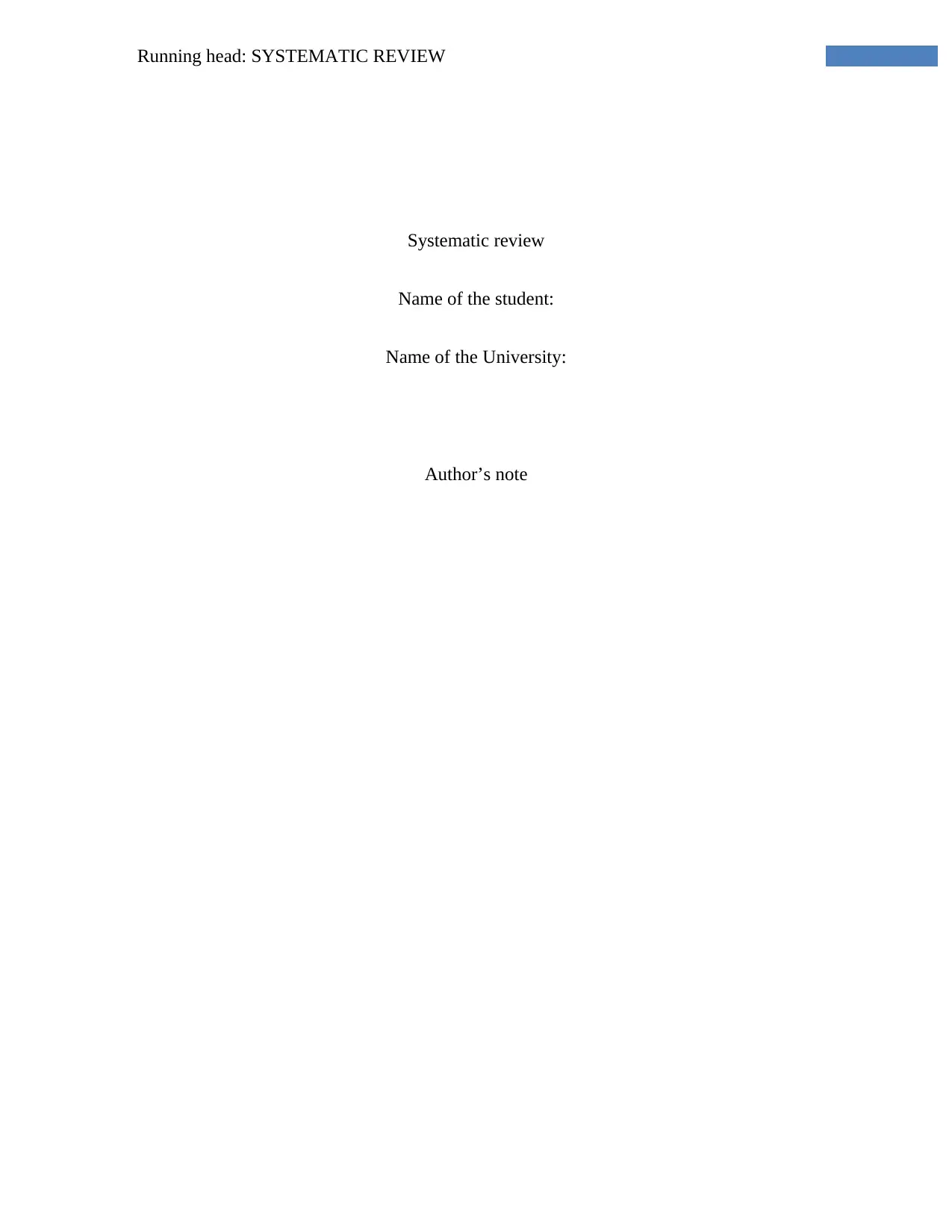
Running head: SYSTEMATIC REVIEW
Systematic review
Name of the student:
Name of the University:
Author’s note
Systematic review
Name of the student:
Name of the University:
Author’s note
Paraphrase This Document
Need a fresh take? Get an instant paraphrase of this document with our AI Paraphraser
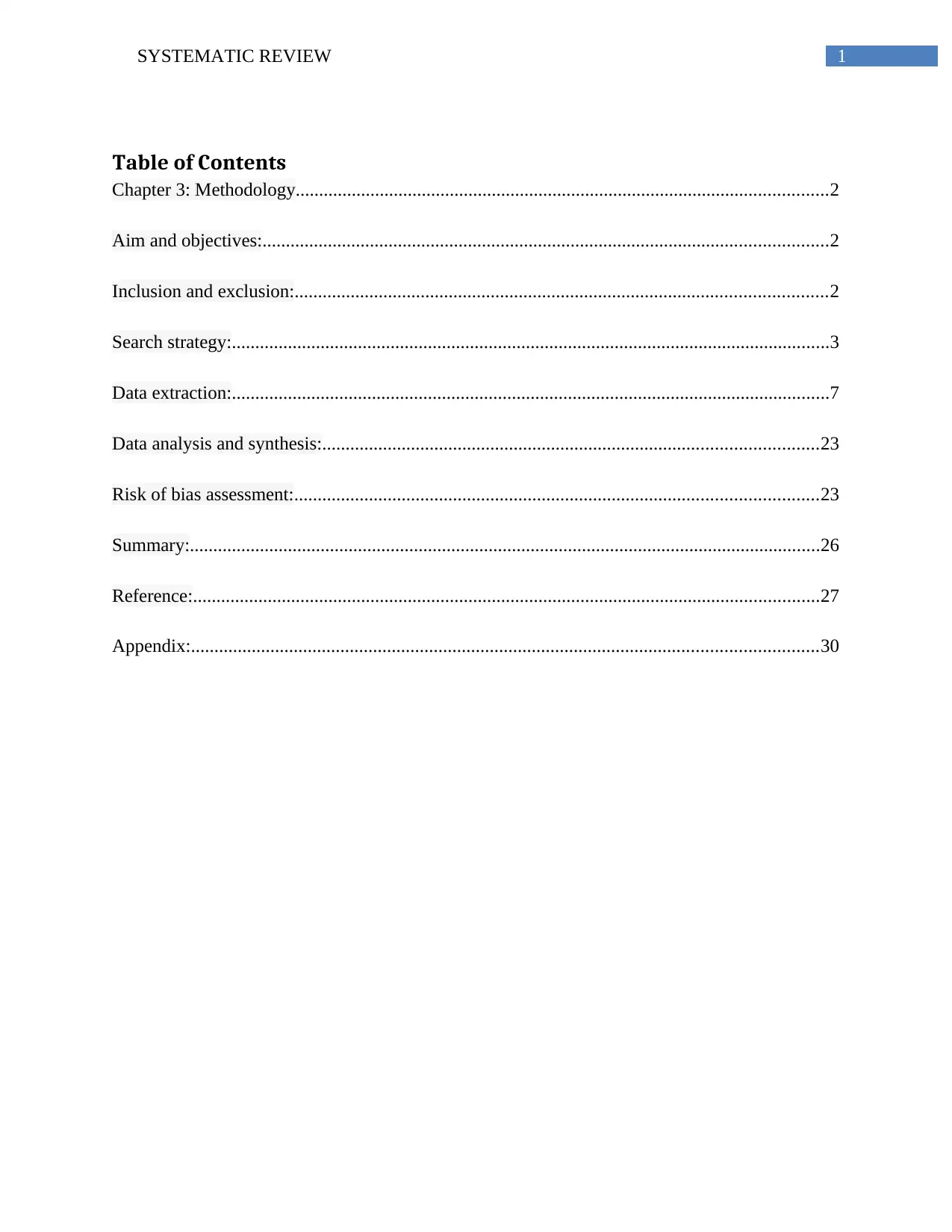
1SYSTEMATIC REVIEW
Table of Contents
Chapter 3: Methodology..................................................................................................................2
Aim and objectives:.........................................................................................................................2
Inclusion and exclusion:..................................................................................................................2
Search strategy:................................................................................................................................3
Data extraction:................................................................................................................................7
Data analysis and synthesis:..........................................................................................................23
Risk of bias assessment:................................................................................................................23
Summary:.......................................................................................................................................26
Reference:......................................................................................................................................27
Appendix:......................................................................................................................................30
Table of Contents
Chapter 3: Methodology..................................................................................................................2
Aim and objectives:.........................................................................................................................2
Inclusion and exclusion:..................................................................................................................2
Search strategy:................................................................................................................................3
Data extraction:................................................................................................................................7
Data analysis and synthesis:..........................................................................................................23
Risk of bias assessment:................................................................................................................23
Summary:.......................................................................................................................................26
Reference:......................................................................................................................................27
Appendix:......................................................................................................................................30
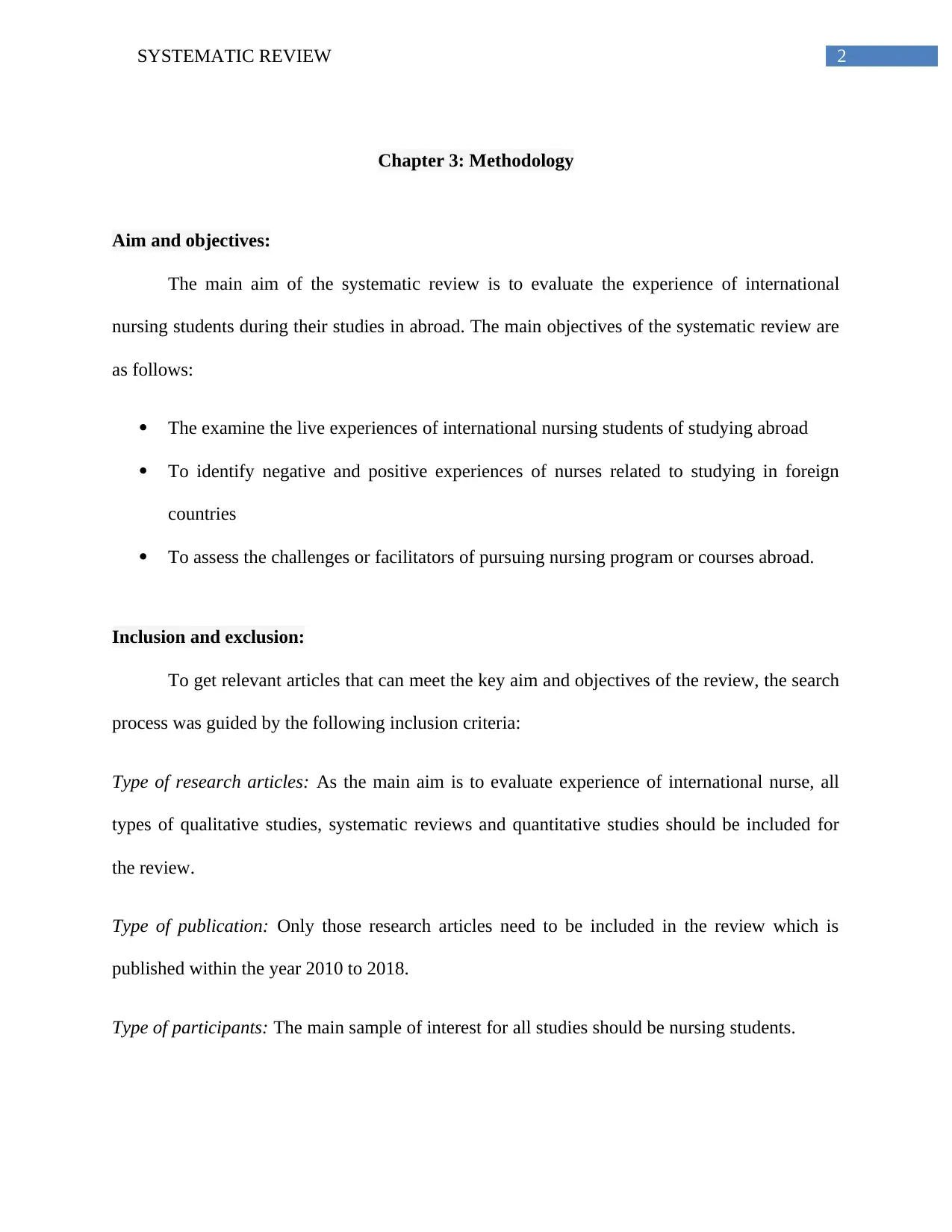
2SYSTEMATIC REVIEW
Chapter 3: Methodology
Aim and objectives:
The main aim of the systematic review is to evaluate the experience of international
nursing students during their studies in abroad. The main objectives of the systematic review are
as follows:
The examine the live experiences of international nursing students of studying abroad
To identify negative and positive experiences of nurses related to studying in foreign
countries
To assess the challenges or facilitators of pursuing nursing program or courses abroad.
Inclusion and exclusion:
To get relevant articles that can meet the key aim and objectives of the review, the search
process was guided by the following inclusion criteria:
Type of research articles: As the main aim is to evaluate experience of international nurse, all
types of qualitative studies, systematic reviews and quantitative studies should be included for
the review.
Type of publication: Only those research articles need to be included in the review which is
published within the year 2010 to 2018.
Type of participants: The main sample of interest for all studies should be nursing students.
Chapter 3: Methodology
Aim and objectives:
The main aim of the systematic review is to evaluate the experience of international
nursing students during their studies in abroad. The main objectives of the systematic review are
as follows:
The examine the live experiences of international nursing students of studying abroad
To identify negative and positive experiences of nurses related to studying in foreign
countries
To assess the challenges or facilitators of pursuing nursing program or courses abroad.
Inclusion and exclusion:
To get relevant articles that can meet the key aim and objectives of the review, the search
process was guided by the following inclusion criteria:
Type of research articles: As the main aim is to evaluate experience of international nurse, all
types of qualitative studies, systematic reviews and quantitative studies should be included for
the review.
Type of publication: Only those research articles need to be included in the review which is
published within the year 2010 to 2018.
Type of participants: The main sample of interest for all studies should be nursing students.
⊘ This is a preview!⊘
Do you want full access?
Subscribe today to unlock all pages.

Trusted by 1+ million students worldwide
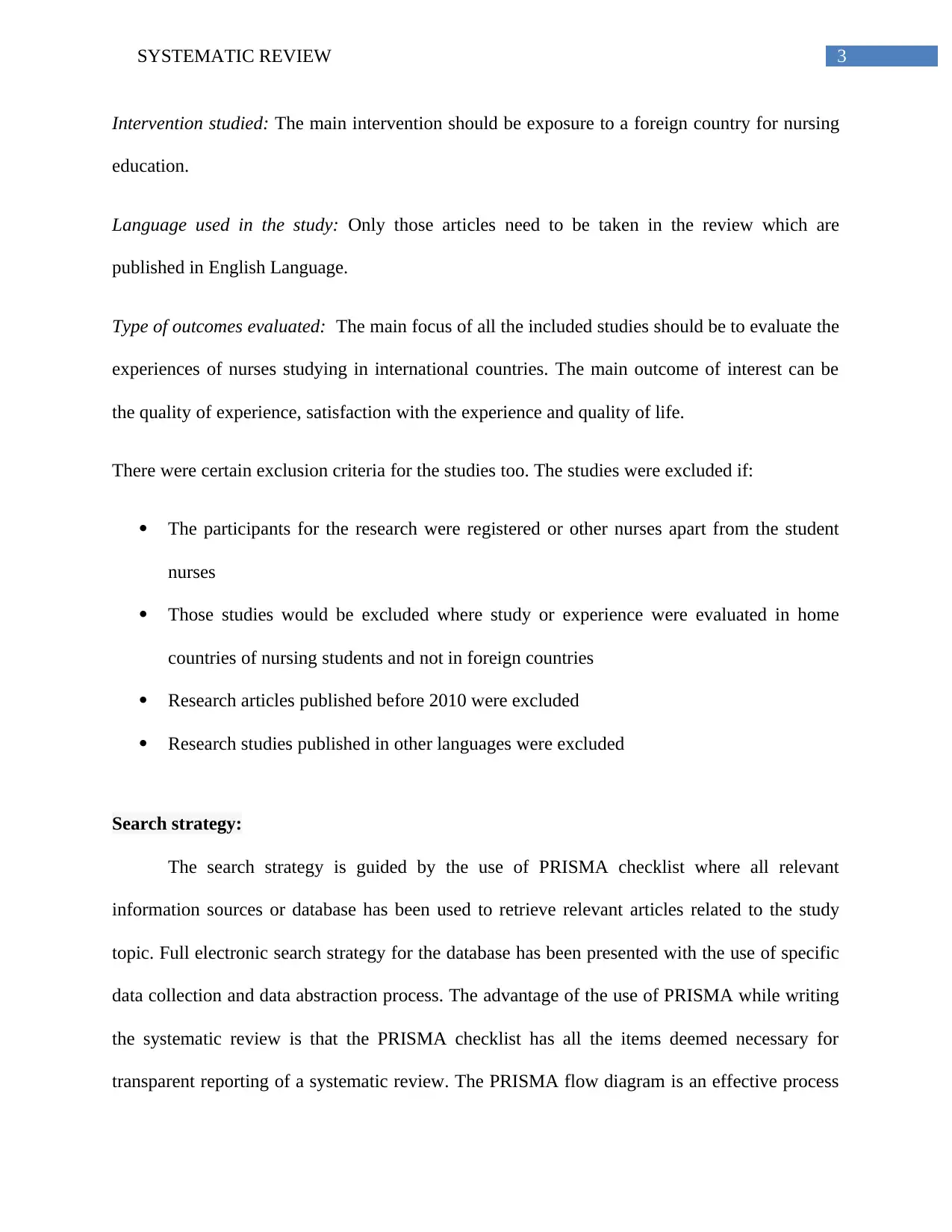
3SYSTEMATIC REVIEW
Intervention studied: The main intervention should be exposure to a foreign country for nursing
education.
Language used in the study: Only those articles need to be taken in the review which are
published in English Language.
Type of outcomes evaluated: The main focus of all the included studies should be to evaluate the
experiences of nurses studying in international countries. The main outcome of interest can be
the quality of experience, satisfaction with the experience and quality of life.
There were certain exclusion criteria for the studies too. The studies were excluded if:
The participants for the research were registered or other nurses apart from the student
nurses
Those studies would be excluded where study or experience were evaluated in home
countries of nursing students and not in foreign countries
Research articles published before 2010 were excluded
Research studies published in other languages were excluded
Search strategy:
The search strategy is guided by the use of PRISMA checklist where all relevant
information sources or database has been used to retrieve relevant articles related to the study
topic. Full electronic search strategy for the database has been presented with the use of specific
data collection and data abstraction process. The advantage of the use of PRISMA while writing
the systematic review is that the PRISMA checklist has all the items deemed necessary for
transparent reporting of a systematic review. The PRISMA flow diagram is an effective process
Intervention studied: The main intervention should be exposure to a foreign country for nursing
education.
Language used in the study: Only those articles need to be taken in the review which are
published in English Language.
Type of outcomes evaluated: The main focus of all the included studies should be to evaluate the
experiences of nurses studying in international countries. The main outcome of interest can be
the quality of experience, satisfaction with the experience and quality of life.
There were certain exclusion criteria for the studies too. The studies were excluded if:
The participants for the research were registered or other nurses apart from the student
nurses
Those studies would be excluded where study or experience were evaluated in home
countries of nursing students and not in foreign countries
Research articles published before 2010 were excluded
Research studies published in other languages were excluded
Search strategy:
The search strategy is guided by the use of PRISMA checklist where all relevant
information sources or database has been used to retrieve relevant articles related to the study
topic. Full electronic search strategy for the database has been presented with the use of specific
data collection and data abstraction process. The advantage of the use of PRISMA while writing
the systematic review is that the PRISMA checklist has all the items deemed necessary for
transparent reporting of a systematic review. The PRISMA flow diagram is an effective process
Paraphrase This Document
Need a fresh take? Get an instant paraphrase of this document with our AI Paraphraser
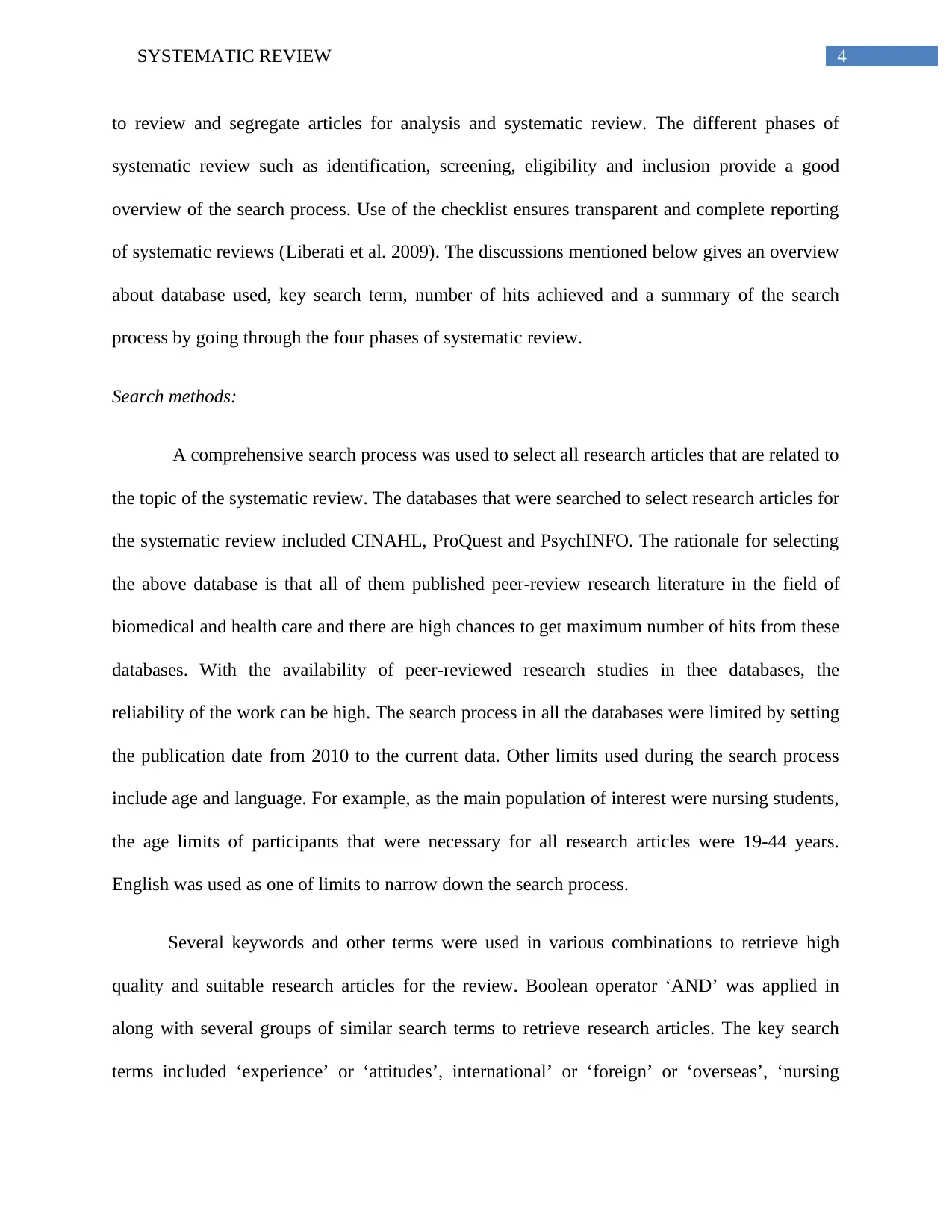
4SYSTEMATIC REVIEW
to review and segregate articles for analysis and systematic review. The different phases of
systematic review such as identification, screening, eligibility and inclusion provide a good
overview of the search process. Use of the checklist ensures transparent and complete reporting
of systematic reviews (Liberati et al. 2009). The discussions mentioned below gives an overview
about database used, key search term, number of hits achieved and a summary of the search
process by going through the four phases of systematic review.
Search methods:
A comprehensive search process was used to select all research articles that are related to
the topic of the systematic review. The databases that were searched to select research articles for
the systematic review included CINAHL, ProQuest and PsychINFO. The rationale for selecting
the above database is that all of them published peer-review research literature in the field of
biomedical and health care and there are high chances to get maximum number of hits from these
databases. With the availability of peer-reviewed research studies in thee databases, the
reliability of the work can be high. The search process in all the databases were limited by setting
the publication date from 2010 to the current data. Other limits used during the search process
include age and language. For example, as the main population of interest were nursing students,
the age limits of participants that were necessary for all research articles were 19-44 years.
English was used as one of limits to narrow down the search process.
Several keywords and other terms were used in various combinations to retrieve high
quality and suitable research articles for the review. Boolean operator ‘AND’ was applied in
along with several groups of similar search terms to retrieve research articles. The key search
terms included ‘experience’ or ‘attitudes’, international’ or ‘foreign’ or ‘overseas’, ‘nursing
to review and segregate articles for analysis and systematic review. The different phases of
systematic review such as identification, screening, eligibility and inclusion provide a good
overview of the search process. Use of the checklist ensures transparent and complete reporting
of systematic reviews (Liberati et al. 2009). The discussions mentioned below gives an overview
about database used, key search term, number of hits achieved and a summary of the search
process by going through the four phases of systematic review.
Search methods:
A comprehensive search process was used to select all research articles that are related to
the topic of the systematic review. The databases that were searched to select research articles for
the systematic review included CINAHL, ProQuest and PsychINFO. The rationale for selecting
the above database is that all of them published peer-review research literature in the field of
biomedical and health care and there are high chances to get maximum number of hits from these
databases. With the availability of peer-reviewed research studies in thee databases, the
reliability of the work can be high. The search process in all the databases were limited by setting
the publication date from 2010 to the current data. Other limits used during the search process
include age and language. For example, as the main population of interest were nursing students,
the age limits of participants that were necessary for all research articles were 19-44 years.
English was used as one of limits to narrow down the search process.
Several keywords and other terms were used in various combinations to retrieve high
quality and suitable research articles for the review. Boolean operator ‘AND’ was applied in
along with several groups of similar search terms to retrieve research articles. The key search
terms included ‘experience’ or ‘attitudes’, international’ or ‘foreign’ or ‘overseas’, ‘nursing
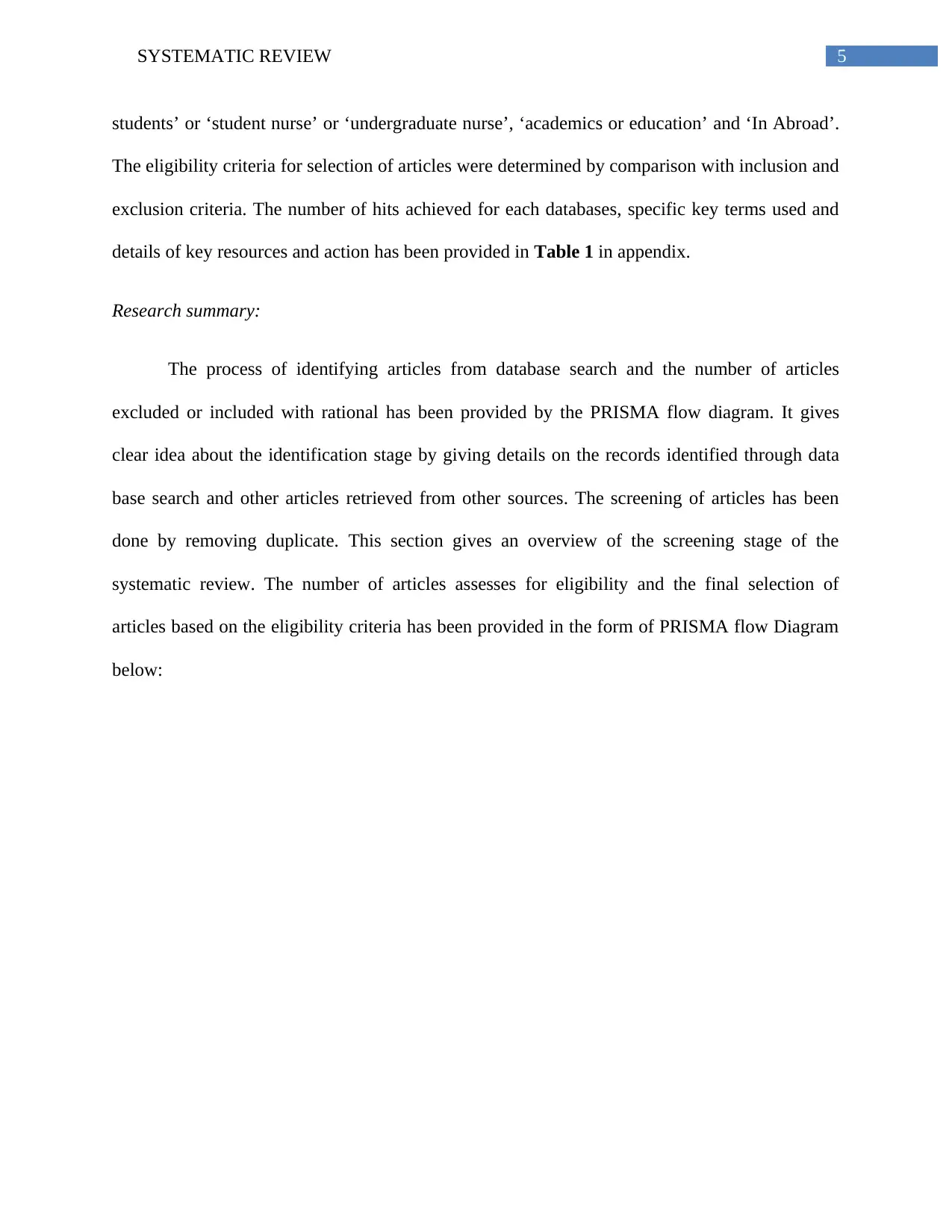
5SYSTEMATIC REVIEW
students’ or ‘student nurse’ or ‘undergraduate nurse’, ‘academics or education’ and ‘In Abroad’.
The eligibility criteria for selection of articles were determined by comparison with inclusion and
exclusion criteria. The number of hits achieved for each databases, specific key terms used and
details of key resources and action has been provided in Table 1 in appendix.
Research summary:
The process of identifying articles from database search and the number of articles
excluded or included with rational has been provided by the PRISMA flow diagram. It gives
clear idea about the identification stage by giving details on the records identified through data
base search and other articles retrieved from other sources. The screening of articles has been
done by removing duplicate. This section gives an overview of the screening stage of the
systematic review. The number of articles assesses for eligibility and the final selection of
articles based on the eligibility criteria has been provided in the form of PRISMA flow Diagram
below:
students’ or ‘student nurse’ or ‘undergraduate nurse’, ‘academics or education’ and ‘In Abroad’.
The eligibility criteria for selection of articles were determined by comparison with inclusion and
exclusion criteria. The number of hits achieved for each databases, specific key terms used and
details of key resources and action has been provided in Table 1 in appendix.
Research summary:
The process of identifying articles from database search and the number of articles
excluded or included with rational has been provided by the PRISMA flow diagram. It gives
clear idea about the identification stage by giving details on the records identified through data
base search and other articles retrieved from other sources. The screening of articles has been
done by removing duplicate. This section gives an overview of the screening stage of the
systematic review. The number of articles assesses for eligibility and the final selection of
articles based on the eligibility criteria has been provided in the form of PRISMA flow Diagram
below:
⊘ This is a preview!⊘
Do you want full access?
Subscribe today to unlock all pages.

Trusted by 1+ million students worldwide
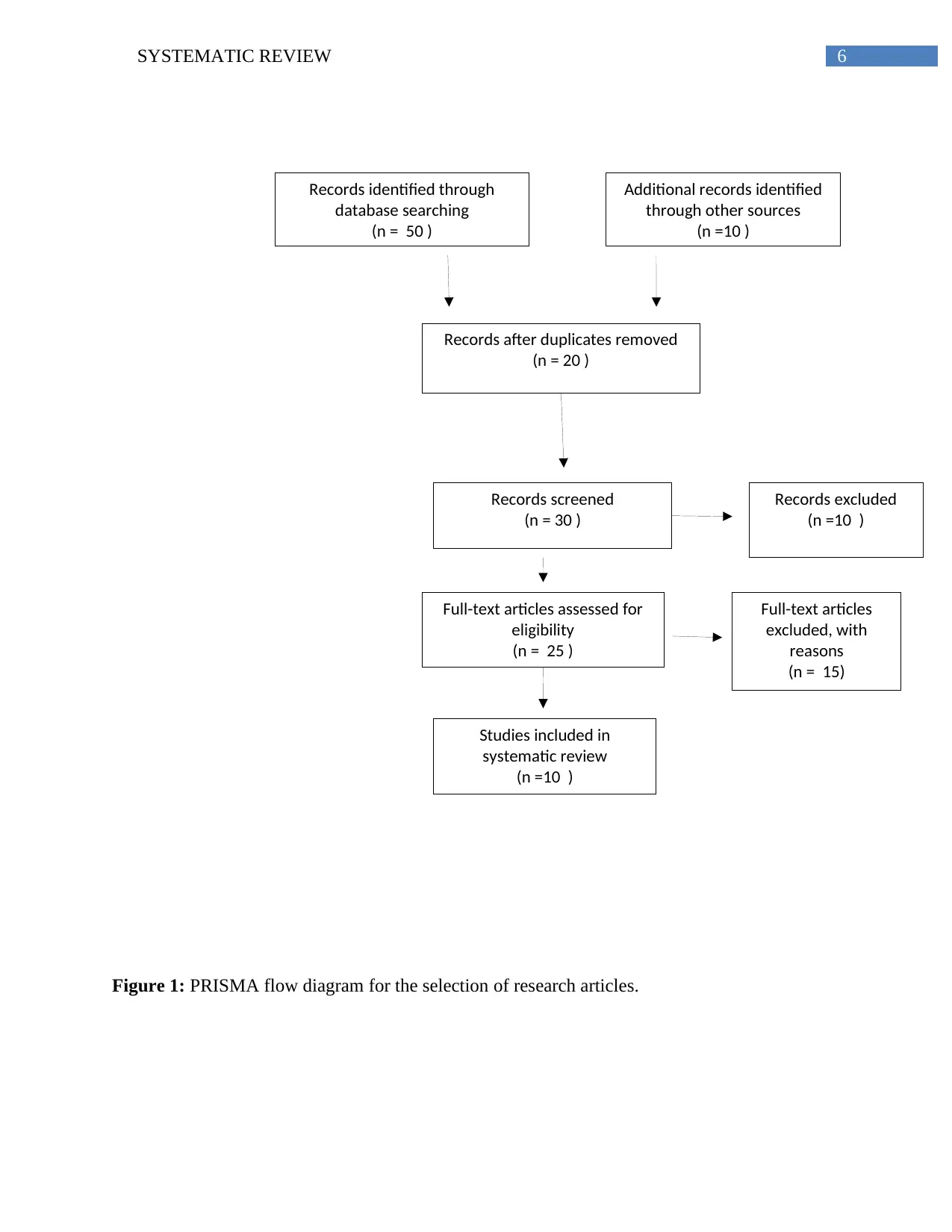
6
Records identified through
database searching
(n = 50 )
Additional records identified
through other sources
(n =10 )
Records after duplicates removed
(n = 20 )
Records screened
(n = 30 )
Records excluded
(n =10 )
Full-text articles assessed for
eligibility
(n = 25 )
Studies included in
systematic review
(n =10 )
Full-text articles
excluded, with
reasons
(n = 15)
SYSTEMATIC REVIEW
Figure 1: PRISMA flow diagram for the selection of research articles.
Records identified through
database searching
(n = 50 )
Additional records identified
through other sources
(n =10 )
Records after duplicates removed
(n = 20 )
Records screened
(n = 30 )
Records excluded
(n =10 )
Full-text articles assessed for
eligibility
(n = 25 )
Studies included in
systematic review
(n =10 )
Full-text articles
excluded, with
reasons
(n = 15)
SYSTEMATIC REVIEW
Figure 1: PRISMA flow diagram for the selection of research articles.
Paraphrase This Document
Need a fresh take? Get an instant paraphrase of this document with our AI Paraphraser
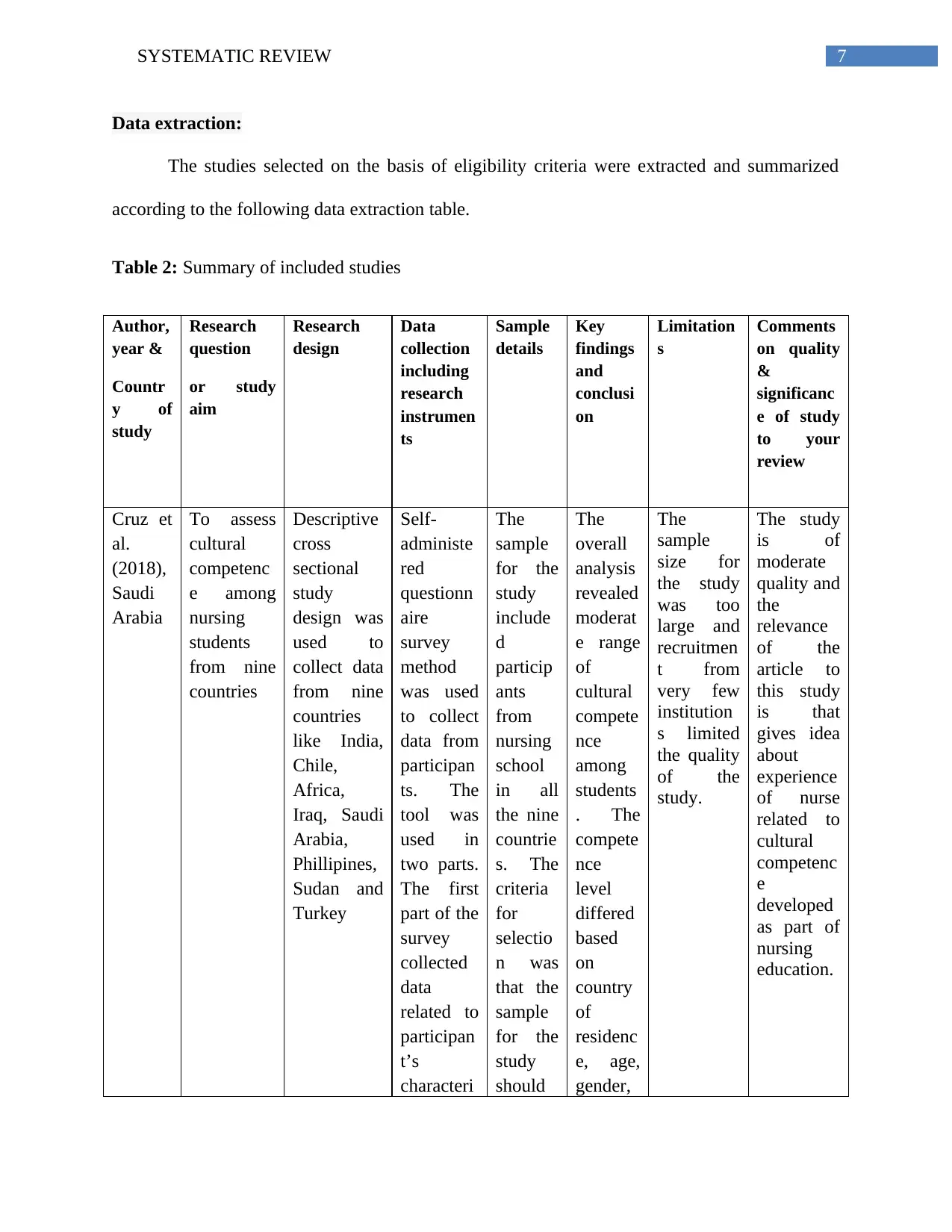
7SYSTEMATIC REVIEW
Data extraction:
The studies selected on the basis of eligibility criteria were extracted and summarized
according to the following data extraction table.
Table 2: Summary of included studies
Author,
year &
Countr
y of
study
Research
question
or study
aim
Research
design
Data
collection
including
research
instrumen
ts
Sample
details
Key
findings
and
conclusi
on
Limitation
s
Comments
on quality
&
significanc
e of study
to your
review
Cruz et
al.
(2018),
Saudi
Arabia
To assess
cultural
competenc
e among
nursing
students
from nine
countries
Descriptive
cross
sectional
study
design was
used to
collect data
from nine
countries
like India,
Chile,
Africa,
Iraq, Saudi
Arabia,
Phillipines,
Sudan and
Turkey
Self-
administe
red
questionn
aire
survey
method
was used
to collect
data from
participan
ts. The
tool was
used in
two parts.
The first
part of the
survey
collected
data
related to
participan
t’s
characteri
The
sample
for the
study
include
d
particip
ants
from
nursing
school
in all
the nine
countrie
s. The
criteria
for
selectio
n was
that the
sample
for the
study
should
The
overall
analysis
revealed
moderat
e range
of
cultural
compete
nce
among
students
. The
compete
nce
level
differed
based
on
country
of
residenc
e, age,
gender,
The
sample
size for
the study
was too
large and
recruitmen
t from
very few
institution
s limited
the quality
of the
study.
The study
is of
moderate
quality and
the
relevance
of the
article to
this study
is that
gives idea
about
experience
of nurse
related to
cultural
competenc
e
developed
as part of
nursing
education.
Data extraction:
The studies selected on the basis of eligibility criteria were extracted and summarized
according to the following data extraction table.
Table 2: Summary of included studies
Author,
year &
Countr
y of
study
Research
question
or study
aim
Research
design
Data
collection
including
research
instrumen
ts
Sample
details
Key
findings
and
conclusi
on
Limitation
s
Comments
on quality
&
significanc
e of study
to your
review
Cruz et
al.
(2018),
Saudi
Arabia
To assess
cultural
competenc
e among
nursing
students
from nine
countries
Descriptive
cross
sectional
study
design was
used to
collect data
from nine
countries
like India,
Chile,
Africa,
Iraq, Saudi
Arabia,
Phillipines,
Sudan and
Turkey
Self-
administe
red
questionn
aire
survey
method
was used
to collect
data from
participan
ts. The
tool was
used in
two parts.
The first
part of the
survey
collected
data
related to
participan
t’s
characteri
The
sample
for the
study
include
d
particip
ants
from
nursing
school
in all
the nine
countrie
s. The
criteria
for
selectio
n was
that the
sample
for the
study
should
The
overall
analysis
revealed
moderat
e range
of
cultural
compete
nce
among
students
. The
compete
nce
level
differed
based
on
country
of
residenc
e, age,
gender,
The
sample
size for
the study
was too
large and
recruitmen
t from
very few
institution
s limited
the quality
of the
study.
The study
is of
moderate
quality and
the
relevance
of the
article to
this study
is that
gives idea
about
experience
of nurse
related to
cultural
competenc
e
developed
as part of
nursing
education.
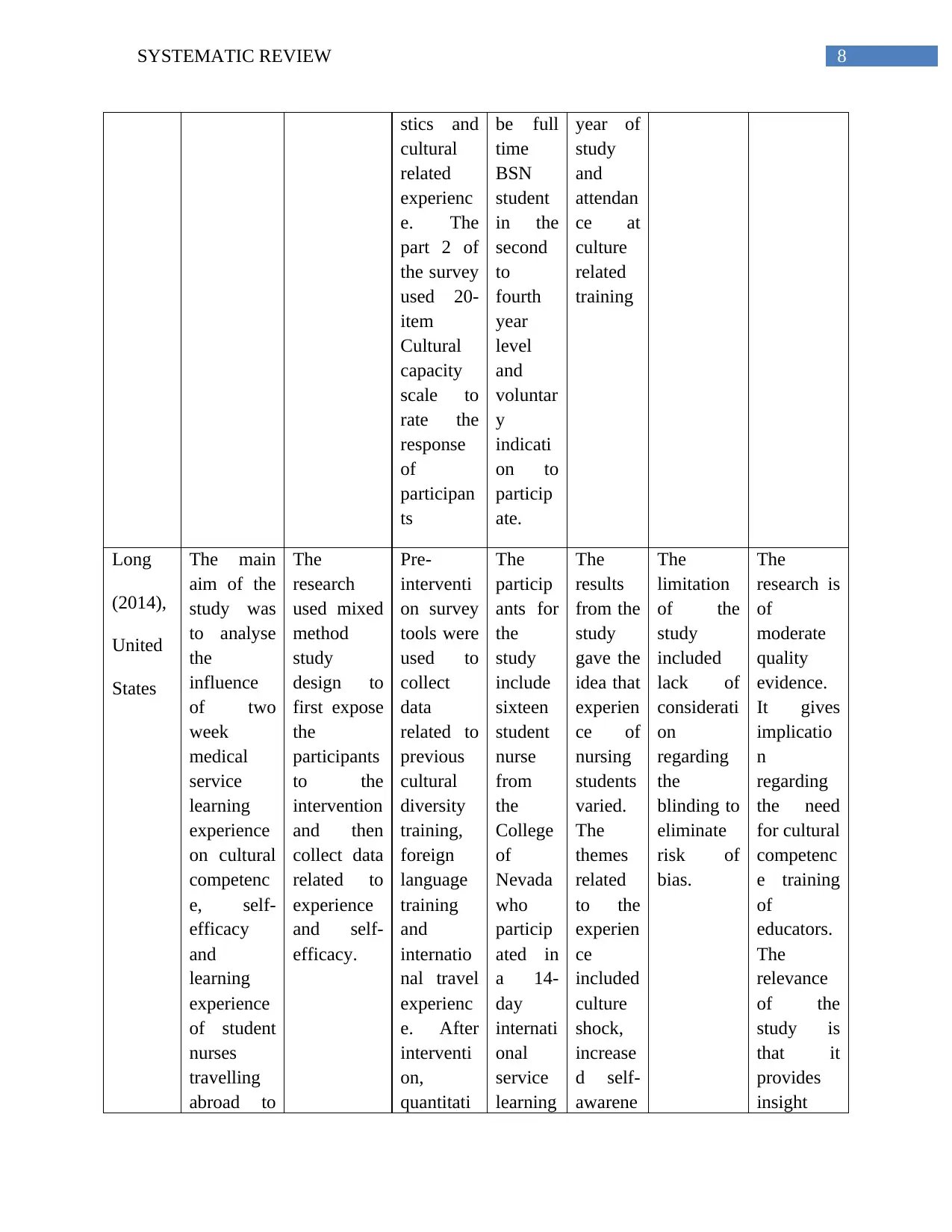
8SYSTEMATIC REVIEW
stics and
cultural
related
experienc
e. The
part 2 of
the survey
used 20-
item
Cultural
capacity
scale to
rate the
response
of
participan
ts
be full
time
BSN
student
in the
second
to
fourth
year
level
and
voluntar
y
indicati
on to
particip
ate.
year of
study
and
attendan
ce at
culture
related
training
Long
(2014),
United
States
The main
aim of the
study was
to analyse
the
influence
of two
week
medical
service
learning
experience
on cultural
competenc
e, self-
efficacy
and
learning
experience
of student
nurses
travelling
abroad to
The
research
used mixed
method
study
design to
first expose
the
participants
to the
intervention
and then
collect data
related to
experience
and self-
efficacy.
Pre-
interventi
on survey
tools were
used to
collect
data
related to
previous
cultural
diversity
training,
foreign
language
training
and
internatio
nal travel
experienc
e. After
interventi
on,
quantitati
The
particip
ants for
the
study
include
sixteen
student
nurse
from
the
College
of
Nevada
who
particip
ated in
a 14-
day
internati
onal
service
learning
The
results
from the
study
gave the
idea that
experien
ce of
nursing
students
varied.
The
themes
related
to the
experien
ce
included
culture
shock,
increase
d self-
awarene
The
limitation
of the
study
included
lack of
considerati
on
regarding
the
blinding to
eliminate
risk of
bias.
The
research is
of
moderate
quality
evidence.
It gives
implicatio
n
regarding
the need
for cultural
competenc
e training
of
educators.
The
relevance
of the
study is
that it
provides
insight
stics and
cultural
related
experienc
e. The
part 2 of
the survey
used 20-
item
Cultural
capacity
scale to
rate the
response
of
participan
ts
be full
time
BSN
student
in the
second
to
fourth
year
level
and
voluntar
y
indicati
on to
particip
ate.
year of
study
and
attendan
ce at
culture
related
training
Long
(2014),
United
States
The main
aim of the
study was
to analyse
the
influence
of two
week
medical
service
learning
experience
on cultural
competenc
e, self-
efficacy
and
learning
experience
of student
nurses
travelling
abroad to
The
research
used mixed
method
study
design to
first expose
the
participants
to the
intervention
and then
collect data
related to
experience
and self-
efficacy.
Pre-
interventi
on survey
tools were
used to
collect
data
related to
previous
cultural
diversity
training,
foreign
language
training
and
internatio
nal travel
experienc
e. After
interventi
on,
quantitati
The
particip
ants for
the
study
include
sixteen
student
nurse
from
the
College
of
Nevada
who
particip
ated in
a 14-
day
internati
onal
service
learning
The
results
from the
study
gave the
idea that
experien
ce of
nursing
students
varied.
The
themes
related
to the
experien
ce
included
culture
shock,
increase
d self-
awarene
The
limitation
of the
study
included
lack of
considerati
on
regarding
the
blinding to
eliminate
risk of
bias.
The
research is
of
moderate
quality
evidence.
It gives
implicatio
n
regarding
the need
for cultural
competenc
e training
of
educators.
The
relevance
of the
study is
that it
provides
insight
⊘ This is a preview!⊘
Do you want full access?
Subscribe today to unlock all pages.

Trusted by 1+ million students worldwide
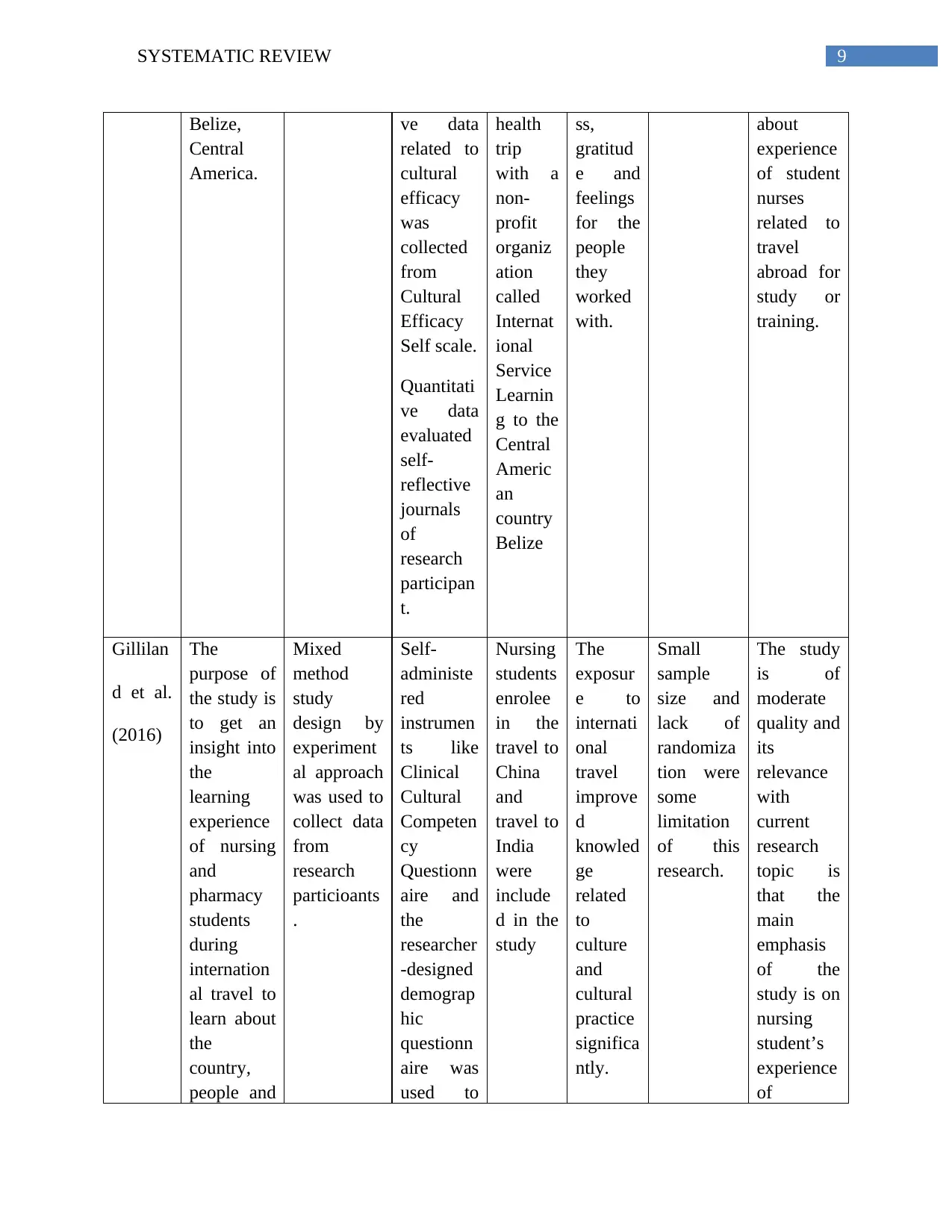
9SYSTEMATIC REVIEW
Belize,
Central
America.
ve data
related to
cultural
efficacy
was
collected
from
Cultural
Efficacy
Self scale.
Quantitati
ve data
evaluated
self-
reflective
journals
of
research
participan
t.
health
trip
with a
non-
profit
organiz
ation
called
Internat
ional
Service
Learnin
g to the
Central
Americ
an
country
Belize
ss,
gratitud
e and
feelings
for the
people
they
worked
with.
about
experience
of student
nurses
related to
travel
abroad for
study or
training.
Gillilan
d et al.
(2016)
The
purpose of
the study is
to get an
insight into
the
learning
experience
of nursing
and
pharmacy
students
during
internation
al travel to
learn about
the
country,
people and
Mixed
method
study
design by
experiment
al approach
was used to
collect data
from
research
particioants
.
Self-
administe
red
instrumen
ts like
Clinical
Cultural
Competen
cy
Questionn
aire and
the
researcher
-designed
demograp
hic
questionn
aire was
used to
Nursing
students
enrolee
in the
travel to
China
and
travel to
India
were
include
d in the
study
The
exposur
e to
internati
onal
travel
improve
d
knowled
ge
related
to
culture
and
cultural
practice
significa
ntly.
Small
sample
size and
lack of
randomiza
tion were
some
limitation
of this
research.
The study
is of
moderate
quality and
its
relevance
with
current
research
topic is
that the
main
emphasis
of the
study is on
nursing
student’s
experience
of
Belize,
Central
America.
ve data
related to
cultural
efficacy
was
collected
from
Cultural
Efficacy
Self scale.
Quantitati
ve data
evaluated
self-
reflective
journals
of
research
participan
t.
health
trip
with a
non-
profit
organiz
ation
called
Internat
ional
Service
Learnin
g to the
Central
Americ
an
country
Belize
ss,
gratitud
e and
feelings
for the
people
they
worked
with.
about
experience
of student
nurses
related to
travel
abroad for
study or
training.
Gillilan
d et al.
(2016)
The
purpose of
the study is
to get an
insight into
the
learning
experience
of nursing
and
pharmacy
students
during
internation
al travel to
learn about
the
country,
people and
Mixed
method
study
design by
experiment
al approach
was used to
collect data
from
research
particioants
.
Self-
administe
red
instrumen
ts like
Clinical
Cultural
Competen
cy
Questionn
aire and
the
researcher
-designed
demograp
hic
questionn
aire was
used to
Nursing
students
enrolee
in the
travel to
China
and
travel to
India
were
include
d in the
study
The
exposur
e to
internati
onal
travel
improve
d
knowled
ge
related
to
culture
and
cultural
practice
significa
ntly.
Small
sample
size and
lack of
randomiza
tion were
some
limitation
of this
research.
The study
is of
moderate
quality and
its
relevance
with
current
research
topic is
that the
main
emphasis
of the
study is on
nursing
student’s
experience
of
Paraphrase This Document
Need a fresh take? Get an instant paraphrase of this document with our AI Paraphraser
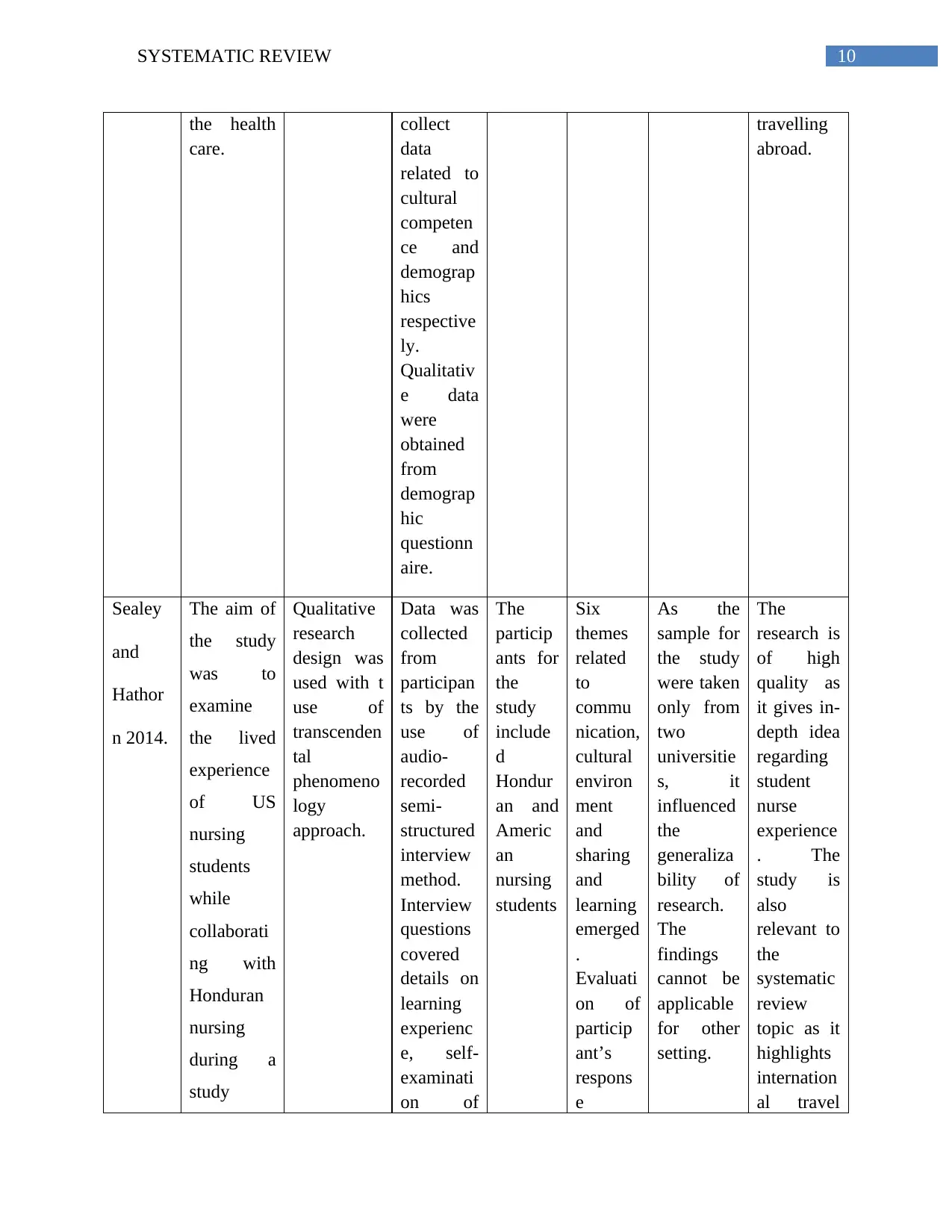
10SYSTEMATIC REVIEW
the health
care.
collect
data
related to
cultural
competen
ce and
demograp
hics
respective
ly.
Qualitativ
e data
were
obtained
from
demograp
hic
questionn
aire.
travelling
abroad.
Sealey
and
Hathor
n 2014.
The aim of
the study
was to
examine
the lived
experience
of US
nursing
students
while
collaborati
ng with
Honduran
nursing
during a
study
Qualitative
research
design was
used with t
use of
transcenden
tal
phenomeno
logy
approach.
Data was
collected
from
participan
ts by the
use of
audio-
recorded
semi-
structured
interview
method.
Interview
questions
covered
details on
learning
experienc
e, self-
examinati
on of
The
particip
ants for
the
study
include
d
Hondur
an and
Americ
an
nursing
students
Six
themes
related
to
commu
nication,
cultural
environ
ment
and
sharing
and
learning
emerged
.
Evaluati
on of
particip
ant’s
respons
e
As the
sample for
the study
were taken
only from
two
universitie
s, it
influenced
the
generaliza
bility of
research.
The
findings
cannot be
applicable
for other
setting.
The
research is
of high
quality as
it gives in-
depth idea
regarding
student
nurse
experience
. The
study is
also
relevant to
the
systematic
review
topic as it
highlights
internation
al travel
the health
care.
collect
data
related to
cultural
competen
ce and
demograp
hics
respective
ly.
Qualitativ
e data
were
obtained
from
demograp
hic
questionn
aire.
travelling
abroad.
Sealey
and
Hathor
n 2014.
The aim of
the study
was to
examine
the lived
experience
of US
nursing
students
while
collaborati
ng with
Honduran
nursing
during a
study
Qualitative
research
design was
used with t
use of
transcenden
tal
phenomeno
logy
approach.
Data was
collected
from
participan
ts by the
use of
audio-
recorded
semi-
structured
interview
method.
Interview
questions
covered
details on
learning
experienc
e, self-
examinati
on of
The
particip
ants for
the
study
include
d
Hondur
an and
Americ
an
nursing
students
Six
themes
related
to
commu
nication,
cultural
environ
ment
and
sharing
and
learning
emerged
.
Evaluati
on of
particip
ant’s
respons
e
As the
sample for
the study
were taken
only from
two
universitie
s, it
influenced
the
generaliza
bility of
research.
The
findings
cannot be
applicable
for other
setting.
The
research is
of high
quality as
it gives in-
depth idea
regarding
student
nurse
experience
. The
study is
also
relevant to
the
systematic
review
topic as it
highlights
internation
al travel
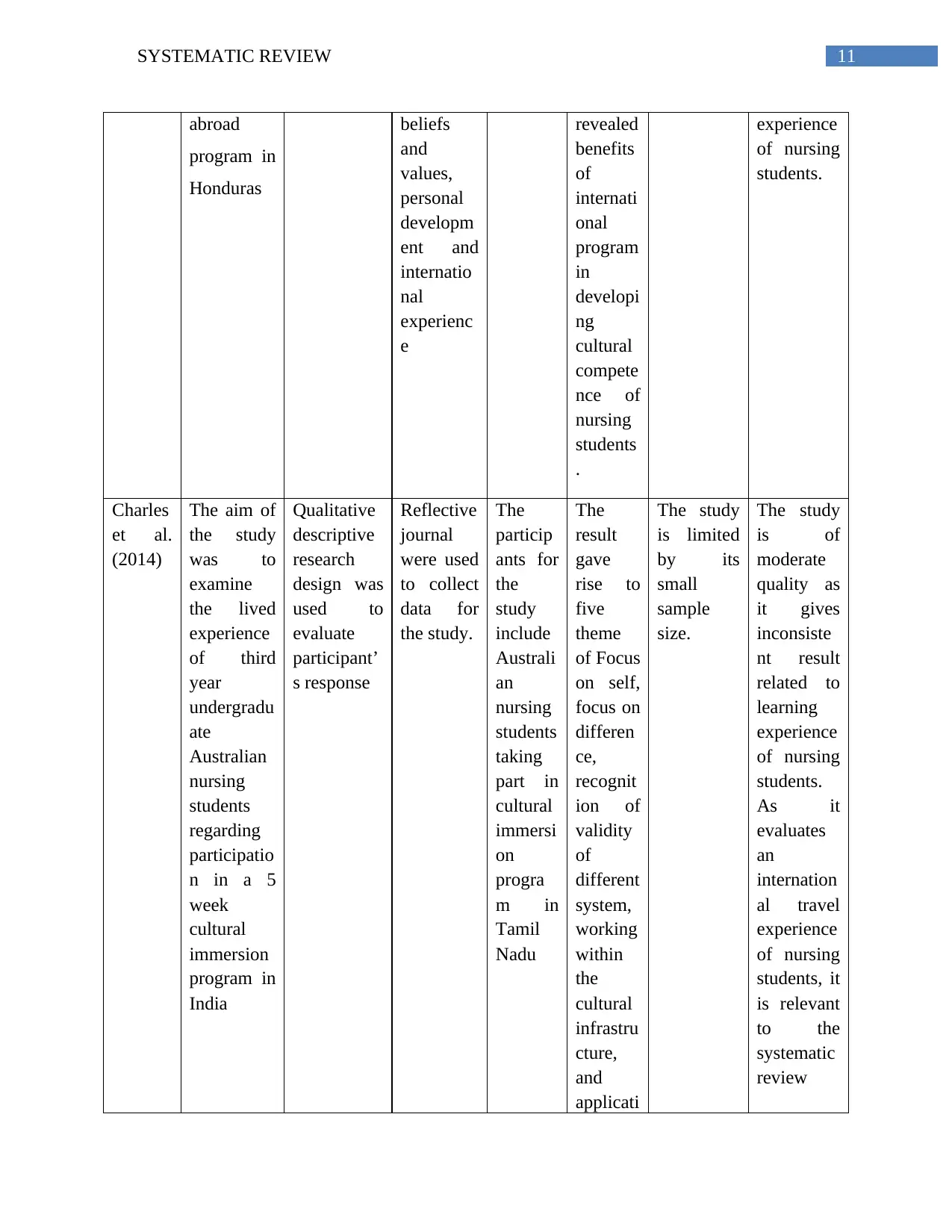
11SYSTEMATIC REVIEW
abroad
program in
Honduras
beliefs
and
values,
personal
developm
ent and
internatio
nal
experienc
e
revealed
benefits
of
internati
onal
program
in
developi
ng
cultural
compete
nce of
nursing
students
.
experience
of nursing
students.
Charles
et al.
(2014)
The aim of
the study
was to
examine
the lived
experience
of third
year
undergradu
ate
Australian
nursing
students
regarding
participatio
n in a 5
week
cultural
immersion
program in
India
Qualitative
descriptive
research
design was
used to
evaluate
participant’
s response
Reflective
journal
were used
to collect
data for
the study.
The
particip
ants for
the
study
include
Australi
an
nursing
students
taking
part in
cultural
immersi
on
progra
m in
Tamil
Nadu
The
result
gave
rise to
five
theme
of Focus
on self,
focus on
differen
ce,
recognit
ion of
validity
of
different
system,
working
within
the
cultural
infrastru
cture,
and
applicati
The study
is limited
by its
small
sample
size.
The study
is of
moderate
quality as
it gives
inconsiste
nt result
related to
learning
experience
of nursing
students.
As it
evaluates
an
internation
al travel
experience
of nursing
students, it
is relevant
to the
systematic
review
abroad
program in
Honduras
beliefs
and
values,
personal
developm
ent and
internatio
nal
experienc
e
revealed
benefits
of
internati
onal
program
in
developi
ng
cultural
compete
nce of
nursing
students
.
experience
of nursing
students.
Charles
et al.
(2014)
The aim of
the study
was to
examine
the lived
experience
of third
year
undergradu
ate
Australian
nursing
students
regarding
participatio
n in a 5
week
cultural
immersion
program in
India
Qualitative
descriptive
research
design was
used to
evaluate
participant’
s response
Reflective
journal
were used
to collect
data for
the study.
The
particip
ants for
the
study
include
Australi
an
nursing
students
taking
part in
cultural
immersi
on
progra
m in
Tamil
Nadu
The
result
gave
rise to
five
theme
of Focus
on self,
focus on
differen
ce,
recognit
ion of
validity
of
different
system,
working
within
the
cultural
infrastru
cture,
and
applicati
The study
is limited
by its
small
sample
size.
The study
is of
moderate
quality as
it gives
inconsiste
nt result
related to
learning
experience
of nursing
students.
As it
evaluates
an
internation
al travel
experience
of nursing
students, it
is relevant
to the
systematic
review
⊘ This is a preview!⊘
Do you want full access?
Subscribe today to unlock all pages.

Trusted by 1+ million students worldwide
1 out of 33
Related Documents
Your All-in-One AI-Powered Toolkit for Academic Success.
+13062052269
info@desklib.com
Available 24*7 on WhatsApp / Email
![[object Object]](/_next/static/media/star-bottom.7253800d.svg)
Unlock your academic potential
Copyright © 2020–2025 A2Z Services. All Rights Reserved. Developed and managed by ZUCOL.




